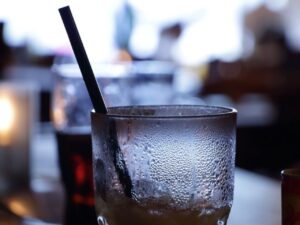[imagesource: here]
Gin is a staple of any decent liquor cabinet, and there are few things better than a good old gin and tonic after a long day – or any day for that matter.
But how much do you actually know about the alcohol that has sparked a trend of craft gins, cocktails, and gin bars?
Today, sipping a gin and tonic is just another way to enjoy your favourite spirit and mixer, but the history of how we got to this point is as macabre as it is interesting.
We could go all the way back to when it was used to treat circulation in the 16th century, but let’s jump ahead to the juicy bits, with How Stuff Works.
In 1857, the Brits took over full governance of India, which is a nice way of saying they colonised the hell out of it.
Early immigrants struggled with the tropical climate and the ravages of malaria – not to mention scurvy after the long sea voyages. The remedy? The quinine rich tonic water, combined with gin and lemon, which proved to be the perfect cure.
This led to the invention of classic gin cocktails like the gin and tonic, the pink gin, and the gimlet.
Malaria was a plague on sailors and British colonists living in tropical climates. For centuries, natives of South America chewed on the bark of the chinchona tree to combat the symptoms of malaria.
The bark contains a natural chemical called quinine that not only calms the muscle aches and spasms caused by malaria, but disrupts the malaria parasite’s metabolism, eventually killing it.
European doctors got wind of this, and started prescribing the bark to British soldiers and colonists in India. As I’m sure you can imagine, chewing bark wasn’t a pleasant experience, so when a water-soluble form of quinine was invented in the 1850s, which lead to the bottling of the first “Indian quinine tonics”, everyone was relieved.
Meanwhile, back on the ships, the British Navy was making the rounds to every port in the world, and bringing bottles of dry gin with them.

Soon the tonic was mixed with the gin and consumed to treat all sorts of ailments, such as malaria, but also probably boredom on long sea voyages.
Bitters was also cited as a treatment for a number of diseases, which when added to gin turned it pink – and that’s how pink gin was born.
We have our own contemporary version of pink gin here in South Africa but that’s something entirely different.
On to scurvy, and other key players in the invention of a popular gin cocktail.
Scurvy can be easily cured with citrus fruit, but fresh citrus doesn’t last long aboard a ship. Sailors tried to boil and condense lime juice, but the process cooked out the vitamin C. Eventually, a Scottish scientists named Lachlan Rose figured out a way to preserve lime juice by mixing it with a small quantity of sulphur dioxide.

Rose’s Lime Juice became a shipboard staple, and it wasn’t long before it was being mixed with gin to make a classic gimlet.
Most of us don’t have to deal with scurvy or long sea voyages, and there are meds for treating malaria now, so the gin and tonic has evolved into a drink consumed by people around the world who enjoy the finer things in life.
If you’re one of those people, your first port of call for a G&T should be a finely perfected craft gin, like the Cape Town Gin Classic Dry; your pink gin should be a Pink Lady infused with hibiscus flowers and rose petals; and while you don’t need to consume gin medicinally, there’s no harm in necking a few of these:
Tip for the wise – The Cape Town Gin Rooibos Red tastes just as good on its own as it does in a cocktail.
If you’re keen to try any of the above, go here to order it online and have it delivered to your door.
Now go forth and drink like a sailor.
[source:howstuffworks]






